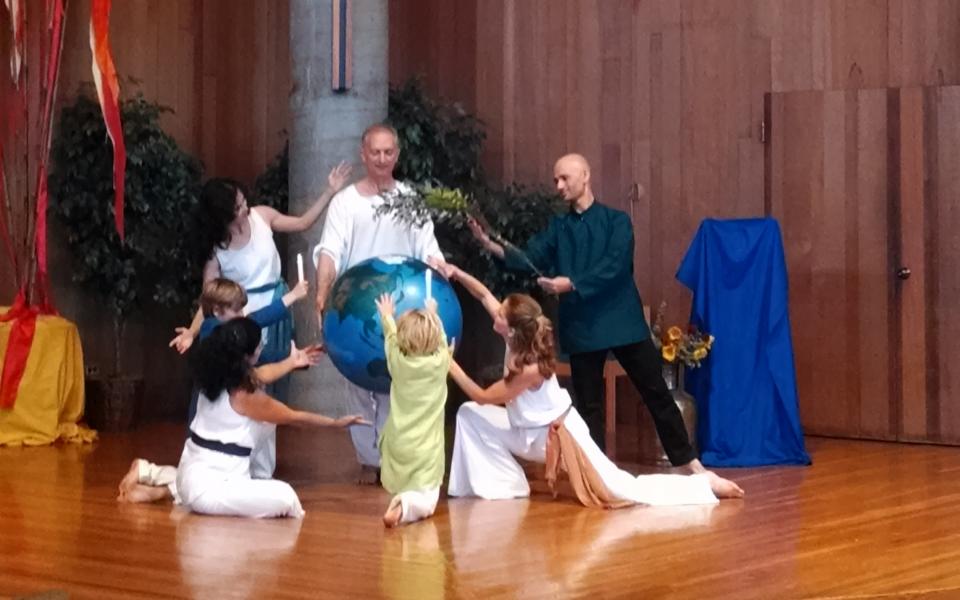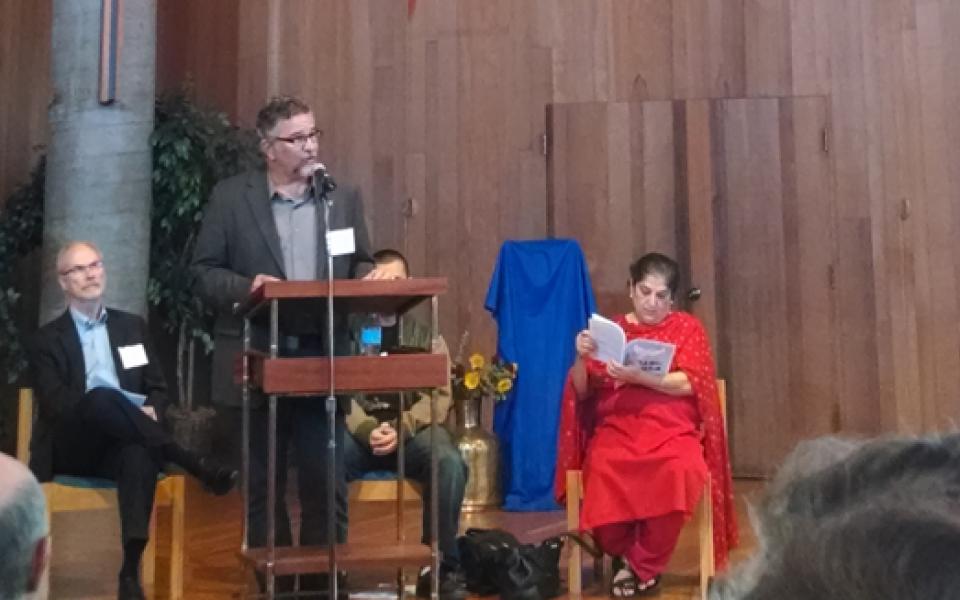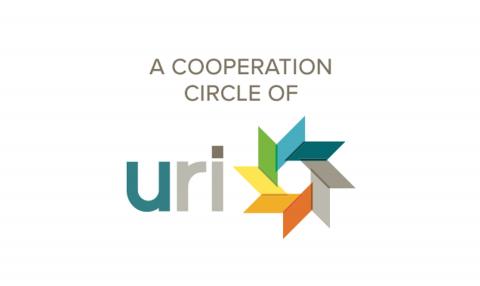
URI Executive Director Victor Kazanjian addressed the Peace Forum 2014 in Berkeley on Saturday November 15 at St. John's Presbyterian Church. The event was organized by the United Nations Association of the East Bay and sponsored by many interfaith organizations including URI Cooperation Circle Women's Interfaith Circle of Service and the URI Global Office. Victor spoke about the power of love to transform situations and build peace.
Victor's talk was the opening keynote for the forum, the topic of which was Forging Peace and Human Security: From Aspiration to Action. The event also included the dance of the The Omega West Dancers and music from the El Djazira Algerian Duo.
A transcript of Victor's speech can be found below.

Good afternoon. It is such a pleasure to be with you today at this Peace Forum and to be in the company of such dedicated peacebuilders. I have just returned from Amman, Jordan where I had the privilege of gathering with grassroots peacebuilders from the Middle East and North Africa. It was an extraordinary experience listening to stories of acts of courage and daring carried out by people of different religious and cultural groups working together to confront violence and injustice in their communities. This, in fact, has been the most consistently inspiring part of my first year as Executive Director of the United Religions Initiative – to witness the work of countless numbers of grassroots activists forging bonds of alliance across lines of difference and forming powerful coalitions to create change in their communities.
What has struck me as particularly important about this work, and that of movements such as the United Religions Initiative, is that the power behind this peacebuilding is less about politics and strategy than it is about relationships and human connection. After three decades of work as a community organizer, a teacher of peace studies and a grassroots activist, I have become convinced that without the power provided by love, compassion and empathy, the most sophisticated strategies are but hollow branches bracing against the winds of injustice and violence. Violence and injustice require the dehumanizing of the other. We know this – in both interpersonal and geopolitical contexts. Therefore, I would submit that an essential component of all peacebuilding and justice-seeking is the “re-humanizing” power of love, compassion and empathy. And so today I would like to reflect with you for a few moments on what I consider to be the roots of peace.
I start today as I often do with a quote from one who inspired my life’s work: Howard Thurman. I knew Dr. Thurman when he was in Boston, but many of you knew him or know of him from his days at the Church for the Fellowship of All Peoples in San Francisco.
Dr. Thurman invites us to consider these words.
“There is a sense of wholeness at the core of humanity
that must abound in all we do;
that marks with reverence our every step,
that has its sway when all else fails;
that wearies out all evil things;
that warms the depths of frozen fears
making friend of foe;
and lasts beyond the living and the dead,
beyond the goals of peace, the ends of war!
This we seek through all our years;
to be complete and of one piece, within and without.”
Go beyond the goals of peace. Go beyond the ends of war. Be complete and of one piece - within and without. That is what I would challenge us to do today: to go beyond our familiar conversations about ending war and violence and establishing peace through merely instrumental means, and envision a new paradigm, an approach to peace that is about completeness, about wholeness within and without; a peace where strategies are based on the values of love, compassion and empathy, and are rooted in the spiritual principles that ground our common life on this planet.
There is a picture on the wall of my office that was given to me by a friend who is an astronaut. It is a picture that she took from the space shuttle, which she was piloting, a picture of the earth from deep in space. Perhaps you have seen something similar. The blue, green earth, a perfectly round ball floating in a sea of black…earth and ocean the only visible distinguishing features. It is a magnificent image: so beautiful, so peaceful, so serene.
Gazing upon that image, it seems unfathomable that upon that beautiful sphere moving through the universe, its inhabitants are locked in life and death struggles with each other. From thousands of miles up in space one is free from the sounds and stench of war and violence, of poverty and oppression, of misogyny and prejudice that plague the peoples of this planet. Reading the daily papers or watching the news rife with stories of this violence, one perhaps yearns for such distance from the suffering below.
But if this was our only view of humanity, as an observer from so far away out in space, we would be unaware that on this same planet, amidst the violence, miracles are occurring every second. At this very moment, new life is being born in India, Pakistan, Nepal and Sri Lanka, in Iraq, Iran and the United States, in Uganda and Nigeria, Argentina and Chile, in the Philippines and Malaysia and to Palestinian and Israeli families. And in each of these places and so many more, people are engaging in acts of compassion and kindness. In each of these places, people are falling in love and forming friendships. And in many of these places, people of different religious and cultural traditions are gathering in circles in their communities to forge bonds of friendship and create cultures of peace.
When we look at the earth from the distance of thousands of miles up in space or the closeness of sitting in a circle of friends and colleagues, we need to see not just the potential for peace, but the reality of peace. We know that peace is not just that which we seek, but that which we know in the embrace of a loved one, through the warmth of friendship, in extending oneself in compassion and empathy towards a stranger, in standing together against violence, injustice and oppression, and in working for interfaith and intercultural understanding and cooperation.
Creating cultures of peace requires participating in the practice of peace, within and without. We who do this work usually focus on the external part of that equation – peace without, believing that it is the systems and structures of society that are both the cause of violence and injustice and its remedy. And this is not wrong. For the earth is in fact a connected whole, a system, a “global commons,” a shared space in which limits on resources and the environment are planetary, economies as well as human systems are inextricably interconnected, and human diversity is ever more apparent among the occupants of this planetary home.
Gazing upon that blue-green ball, we can see how, like the commons of a village which was shared by its inhabitants for water, wood and grazing, the commons which is our planet includes the air we breathe, the water we drink, the seas, forests, and mountains, the diversity of life itself and also that which humankind has created – language; scientific, cultural, and technical knowledge; and health, education, political, justice and economic systems. The “commons” is synonymous with that which we must engage together to sustain life and also implies a shared commitment to community, cooperation, the respect for the rights of others and the corresponding responsibilities that we each share for life on this planet.
There is no question that “to be of one piece without,” as Thurman says, requires our attention to all of those systems which shape our lives as human beings. This is the work that so many of us have been engaged in for so long. It is crucial work. And in the face of so many urgent external threats in areas of health, the environment, economies, human rights, political instability, and regional and global aggression, it is understandable that our focus would be drawn to the world without, and that our work would involve conceiving instruments of peacebuilding that engage these issues and create the conditions for peace and human security.
But when we focus only on the instrumental mechanisms of peacebuilding, we fail to harness what may be the greatest power at our disposal to create cultures of peace, justice and healing for the Earth and all living beings as we say at URI. This power, as Dr. Thurman teaches us, emanates from the world within. It is a power flowing from the wholeness that is at the heart of humanity and indeed at the heart of life itself. It is the power of the human spirit. It is the feeling that we know when we hold a child in our arms, or are held by a beloved, or when we feel at home in the universe. It is love…and love’s expressions: compassion, empathy, kindness, and generosity. It is the unbreakable bonds of human connection forged through the building of sustainable relationships.
I have seen this in the bonds of friendship between Muslim, Christian and Hindu women in Gujarat, India; each of whom lost loved ones to the insanity of violence following the Ayodhya train bombing and riots, and who now work daily side by side for peace in their communities. I have seen it in Israeli and Palestinian youth who defy their peers and politicians and reach across emotional and physical boundaries to declare together, “we refuse to be enemies” - no matter what the future brings. The examples are endless. Each of us has seen the power of love, compassion and empathy in action. But these are not the stories that we tell about conflict and peace. The world is addicted to the gruesome tales of death and destruction, violence and injustice, and when we allow the power of love and relationship to be sentimentalized and marginalized, our peacebuilding efforts are stripped of heart and soul, creating a vacuum into which those who teach fear and hatred happily take control. The rise of extremist movements around the world can be attributed to many factors, but one needs to be understood as a failure to love.
The failure to embody the full potential of love in human community is evidenced by religious communities who claim exclusive ownership of the truth and diminish the beliefs of others. It is evidenced by cultural and ethnic communities who claim superiority over others, and fuel intergroup violence around the world. The rise of violence against women and children needs to be understood in part as the absence of basic human values of love, compassion and empathy. A human society deprived of love and its related social needs, is a society moving towards social insanity, the affects of which no amount of instrumental peacebuilding can reverse.
In such a situation, we end up at worst in genocidal struggles pitting one group against another, and at best our best efforts often lead to people merely tolerating each other. Without love, tolerance maybe the best we can hope for. But such tolerance is merely conflict arrested. It is neither peace nor justice. It is a great harness applied to the destructive forces of ignorance, fear and prejudice. It provides a wall between warring parties. At best tolerance is a glass wall where protected people can see one another going about parallel lives. But nonetheless it is still a wall dividing us from each another. As such, tolerance is not a basis for healthy loving human relationship nor will it ever lead to peace, for tolerance does not allow for learning, or growth, or transformation, or human connection, but rather ultimately keeps people in a state of suspended ignorance and conflict.
True peace and justice that transforms conflict and creates sustainable community requires the embracing of interdependence and the interconnectedness of all living beings… Nothing less. And how does this happen? How do we move beyond fear and violence, and even beyond tolerance? How do we create cultures of peace and justice rooted in love, compassion and empathy? I believe that it starts by cultivating meaningful and connected human relationships in which people of different backgrounds, whether this be cultural, religious, political, gender or any identity, forge strong bonds of connection and become living witnesses of the power of love to create cultures and communities of peace and justice. This is what we do in the United Religions Initiative. This is our focus – to create circles of peace – which we call cooperation circles – 650 of them in 85 countries – in which people create and sustain daily, enduring interfaith and intercultural relationships as they work together to address issues of violence and injustice in their communities.
Albert Einstein spoke of such a process.
"A human being,” he said, “is a part of the whole, called by us Universe, a part limited in time and space. That person experiences them self, their thoughts and feelings as something separated from the rest--a kind of optical delusion of their consciousness. This delusion is a kind of prison, restricting us to our own desires and to affection for a few persons nearest to us. Our task must be to free (one another and ourselves) from this prison (of isolation) by widening our circle of compassion to embrace all living creatures and the whole of nature in its beauty."
Such a task, like any worthy effort, involves practice - daily practice - cultivating a spirit of love, compassion and empathy within ourselves, with our circle of familiars, and with others whose backgrounds and beliefs are different from our own. If we weave together such a practice with the plethora of extraordinary peacebuilding strategies available to us, if we combine our efforts working together as partners in one movement sharing connection to common values – then this movement of which we are a part will be fully energized to transform a struggling world into a truer reflection of the wholeness that lies at its core.
My sisters and brothers, may the power of love infuse purpose into our actions that we may be part of extending the reality of the peace that we know in our hearts to this precious planet and its beloved inhabitants.
May we know peace within ourselves.
May we know peace with one another.
May we know peace among the peoples of the planet.

